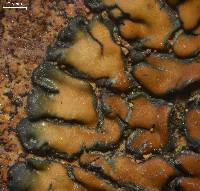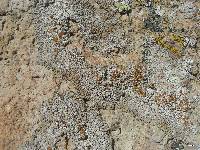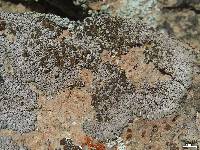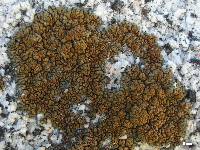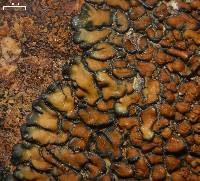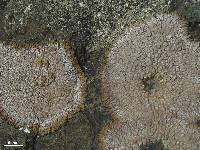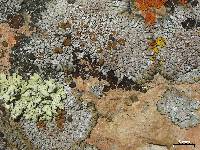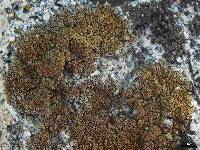
Consortium of Lichen Herbaria
- building a Global Consortium of Bryophytes and Lichens as keystones of cryptobiotic communities -
- Home
- Search
- Images
- Species Checklists
- US States: O-Z >
- US National Parks
- Central America
- South America
- US National Parks
- Southern Subpolar Region
|
|
|
|
Family: Lecanoraceae
|
Nash, T.H., Ryan, B.D., Gries, C., Bungartz, F., (eds.) 2004. Lichen Flora of the Greater Sonoran Desert Region. Vol 2. Thallus: placodioid, areolate, lobate at the margins, usually forming rosettes 3-4 cm in diam.; prothallus: absent, or vestigial and black lobes: concolorous with thallus center or (more frequently) paler, often some shade of yellow; the tips, edges, and parts of upper surface: often becoming bluish or greenish black; soredia: absent surface: orangish yellow, yellowish brown, brown, or sometimes reddish brown or medium olive-brown (in shade often grayish yellow to light yellowish brown), orange centrally, smooth to uneven, often cracked in thallus center, dull or shiny (especially at tips and edges of lobes), pruinose or epruinose, without pale markings, esorediate upper cortex: without dead algal cells, 40-75 µm thick, with cells c. 4 µm in diam. in K; epinecral layer: c. 10 µm thick medulla: moderately loose; partly with granules insoluble in K, with hyphae c. 3 µm in diam.; algal layer: +continuous lower cortex: blue-green, present on marginal lobes Apothecia: often absent or few, one (to several) per areole, adnate to broadly sessile, often partly appearing irregularly areole-like and lobed, 0.5-2(-3) mm in diam. disc: orange, orangish yellow, or yellow (especially in shade), generally concolorous with thallus or (especially when young) paler, plane to convex, usually somewhat shiny margin: usually yellow, slightly deeper color than the disc, 0.1-2 mm wide, entire to wavy or coarsely crenate, +level with disc, often becoming excluded, at least slightly shiny, either without a parathecial ring or ring thin and indistinct amphithecium: present, with a continuous or partially discontinuous algal layer marginally and extending below the hypothecium, with a poorly differentiated medulla (partly with granules insoluble in K), similarly corticate to thallus parathecium: hyaline, with conglutinated hyphae, 15-20 µm thick, poorly differentiated from hypothecium but with the hyphae +periclinally oriented epihymenium: red-brown, densely inspersed with fine granules (soluble in K), usually covered by hyaline, non-inspersed layer, 20-35 µm hymenium: often with yellowish granules (insoluble in K) in some of the paraphyses or asci, (35-)40-65 µm tall; paraphyses: tips: up to 2.5 µm thick, hyaline; subhymenium: pale gray, 30-50 µm thick, without oil droplets; hypothecium: hyaline to pale yellow, 15-50 µm thick, with randomly oriented hyphae asci: clavate, 8-spored ascospores: hyaline, simple, +ellipsoid, 9-12(-15) x (4-)5-6 µm Pycnidia: with reddish or bluish ostioles; conidophores: type III of Vobis (1980) conidia: filiform, +curved, 20-25 µm long Spot tests: thallus K-, C-, KC-; cortex P-; medulla P-, P+ orange, or P+ yellow Secondary metabolites: cortex with unknown brown substance not detected by TLC, or traces of isousnic acid; medulla with fatty acids of the protolichesterinic group (chemotype 1: fatty acids only--typical chemotype), or pannarin plus fatty acids (chemotype 2), or psoromic acid plus fatty acids (chemotype 3). Substrate and ecology: on acidic rock in cool desert to montane areas, usually in sunny habitats, on gently sloping surfaces exposed to intermittent runoff World distribution: mainly north-central California to Washington, especially on the Columbia Plateau Sonoran distribution: southern California at 1500-2500 m. Notes: Lecanora pseudomellea is similar to Lecanora sierrae, but in L. pseudomellea the thallus is yellowish brown to reddish brown and often pruinose, the cortex contains only isousnic acid (minute quantities) or an unknown brown substance (usnic acid is absent), and the medulla contains fatty acids of the protolichesterinic acid group (rather than rangiformic acid). Lecanora pseudomellea is distinguished from L. mellea by the following morphological/anatomical features: 1) cortical type (composed entirely of fungal tissue, without dead algae), 2) relatively loose medulla, 3) larger spores, 4) generally more coarsely incised, flattened to plicate lobes, and 5) frequently pruinose upper surface.Chemical characteristics are also helpful in recognizing L. pseudomellea: presence of the protolichesterinic acid group (see notes under that species), and often pannarin or psoromic acid (not known from L. mellea). |
Powered by Symbiota



